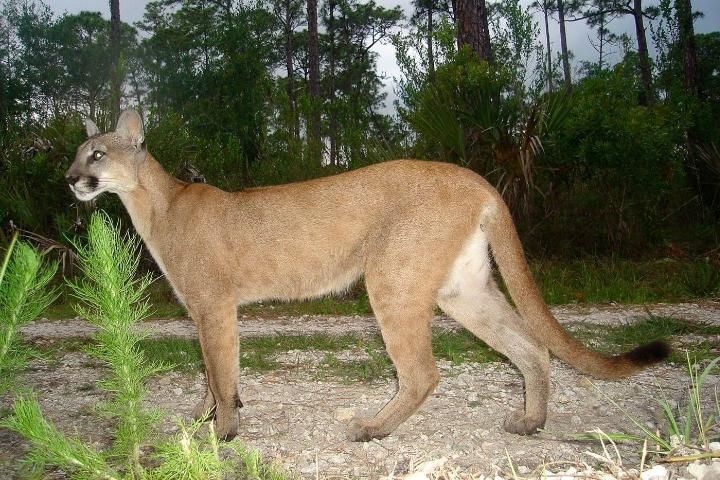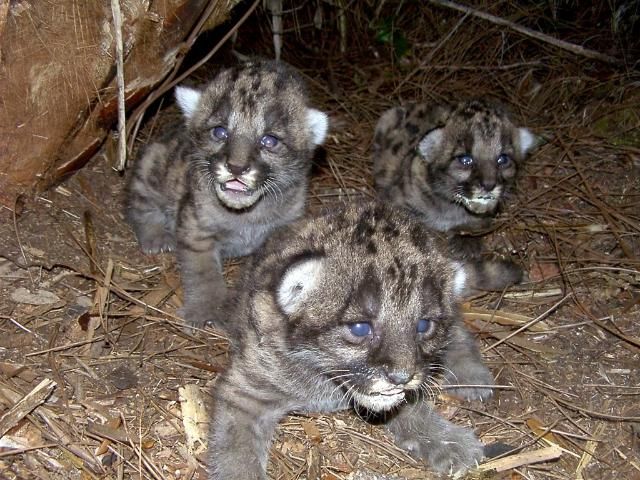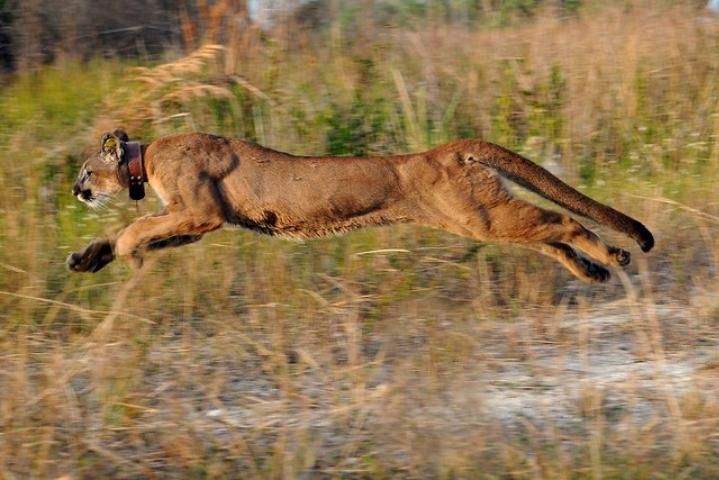Florida's Largest Cat
Breeding: spring, summer, fall, winter
Habitat: grassland, oak hammock, wetland, flatwoods, scrub
Status: Endangered
Scientific Name: Puma concolor coryi
Common name: Florida panther, cougar, mountain lion, panther, puma
Habitat: Habitat generalists including rangelands, forests, prairies, and wetlands. However, a forested component is needed as a source of cover.
Physical Description: Large tan cats with cream-colored chests and black on the backs of their ears. Tails are almost as long as their bodies with a black tip.
Weight: Adult males are 100–160 lbs.; females are 70–100 lbs.
Reproductive Rate: Females mature around 1.5–2 years old; males mature around 3 years old. Gestation is 92–96 days, and litters range from 1–4 kittens with an average of 2.5 kittens.
Lifespan: Up to 20 years
Dispersal & Home Range: Female panthers disperse on average 12 miles and their home ranges may overlap their mothers'. Average dispersal for young males is 42 miles. Males are often forced to disperse greater distances due to competition with older dominant males. Males have larger home ranges than females and can require upwards of 378 mi2.

Credit: Larry W. Richardson/USFWS
Biology and Behavior
Panthers are strict carnivores, with more than 80% of their diet consisting of white-tailed deer, feral swine, opossums, armadillos, and raccoons. Although livestock is not their preferred prey, panthers may opportunistically prey upon domestic animals. Panthers often cache their kills, raking twigs, leaves, and debris over them to protect them from scavengers. Panthers are solitary, efficient hunters that stalk and ambush their prey. They are most active at dusk and dawn. Females give birth to kittens in dens they make in palmetto and other thick vegetation. Denning occurs year-round with a peak from March to July. Kittens learn to hunt from their mothers and begin making small kills at about nine months. Young panthers eventually separate from their mothers around 1.5–2 years old.
Distribution
The Florida panther is currently listed as an endangered subspecies of Puma concolor, a species with a broad geographic distribution extending from western Canada and southward through the western United States, Central and South America, and to southern Chile. Historically, pumas ranged throughout the United States. Today, the Florida panther represents the only breeding population of puma east of the Mississippi River and is restricted to a single breeding population south of the Caloosahatchee River in Florida. Males have consistently been found north of the river, with one individual documented as far north as Georgia in 2008. In 2017, two breeding females were documented north of the Caloosahatchee River for the first time since 1973.

Credit: FWC, https://myfwc.com/wildlifehabitats/wildlife/panther/description/
Did you know?
Panthers cannot roar but they communicate by chirping, purring, hissing, whistling, and growling.
Fast Facts
- Panthers can consume 20–30 pounds in one meal, and a female with kittens may consume even more.
- Panther kittens have black spots and blue eyes that serve as camouflage and fade as they mature.
- Vehicular collisions are the number one cause of known panther mortalities.

Credit: USFWS/David Shindle
History
Once abundant in the eastern United States, the puma population declined as a result of the expansion of European settlements in the 1800s. Panthers represented a threat to settlers' livestock and competition for game. In 1832, before Florida was established as a state, county courts established a panther bounty. The conversion of land for agricultural use fragmented already diminishing panther populations. Then in the late 1930s and early 1940s, a white-tailed deer eradication program aimed at preventing the spread of disease to cattle greatly reduced the panthers' main prey. The panther was close to extinction in the late 1980s through the mid-1990s with an estimated population of 30–50 adults located in southern Florida. Today, the panther is managed by the Florida Fish and Wildlife Conservation Commission and the US Fish and Wildlife Service. Conservation measures combined with federal protection have successfully increased the population size to an estimated 120–230 adults and juveniles. Despite this success, panthers are still considered endangered and continue to face threats to their survival from habitat loss, vehicular collisions, and disease.

Credit: Tim Donovan/FWC
Genetic Restoration
Managers have successfully used genetic restoration, the movement of genetic material from one population to another in order to increase genetic variation, to increase the panther population. Historically, puma populations in the eastern United States exchanged genetic material and remained robust, but decades of fragmentation and population reductions reduced and isolated the population, dangerously decreasing genetic variation. By the 1980s and 1990s, inbreeding among Florida panthers had caused morphological, health, and reproductive changes, such as kinked tails, heart defects, and undescended testicles in adult males. To mimic the flow of genes that historically occurred across the southeastern United States and improve the Florida panthers' fitness, in 1995 managers released eight female pumas from Texas in Florida. Five of them bred successfully and produced 20 kittens. By 2003 all Texas pumas had either died or been removed from Florida, but their kittens remained, and their genetic contribution to the Florida panther population cannot be overstated. Today, the Florida panther has increased genetic variation, fewer health problems from inbreeding, and an expanding and increasing population.
How You Can Help
- Purchase a panther license plate and help donate to research and management of the Florida panther.
- Report panther sightings to Florida Fish and Wildlife Commission at myfwc.com.
- Donate to the Florida Panther Fund at wildlifeflorida.org.
- Drive slowly and stay alert in panther areas.
More information and fact sheets at edis.ifas.ufl.edu